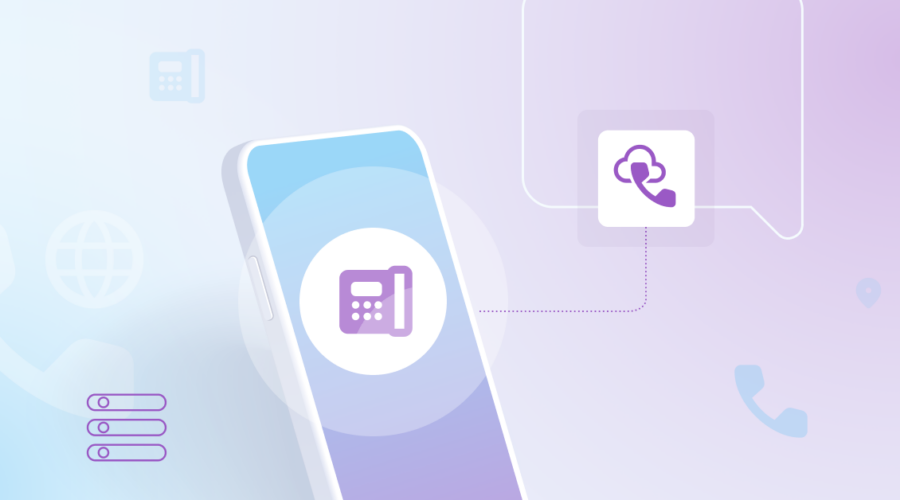How do I choose a SIP trunking provider?
Evaluate your next SIP provider by reviewing technical requirements and important considerations. Our comprehensive checklist will help you easily compare—so you can get connected.


“What is a SIP Trunk?” is a question we get asked a lot by our customers, new hires, and the people we attempt to explain our job to in bars.
To make your life easier (and potentially the lives of your peers), we compiled anything and everything related to SIP trunks in this ultimate guide.
A Session Initiation Protocol (SIP) Trunk is used to transfer voice calls between its origin and destination using the Public Switched Telephone Network (PSTN) or, in the case of a Voice over Internet Protocol (VoIP) call, the internet.
‘Trunking’ is a term that’s been used since the introduction of POTS in the late 19th century. It describes the process of giving multiple callers access to the same telephone service by sharing a line that can handle multiple calls instead of providing an individual line for each call.
Today, the terms trunk and trunking are used in quite confusing ways. Even we’ll admit the telecom industry isn’t great when it comes to clarity. In the case of SIP, a trunk involves transferring IP data from your company’s organization via your Private Branch Exchange (PBX), through your SIP providers’ network via a “SIP trunk”, arriving at another phone or computer.
A lot of telecom companies talk about the cost of ‘channels’ in their SIP trunks, which are usually sold in batches. A ‘channel’ is the amount of data needed to transfer one call through your SIP connection.
If you’re still confused, that’s ok — we are too. An easy way to understand this is to think of channels as lanes on your highway, and the data are the cars driving from a town to the city (or vice versa). If you’re connecting one town to another with the highway, you might only need one or two lanes. However, if multiple towns are connected to the city by the highway, you’ll get traffic jams unless you have many different lanes. To avoid this, you need to ensure you have the right number of lanes for the amount of traffic you expect.
But we have good news. Unlike road building, it’s very possible to dynamically and automatically scale this capacity. Depending on your use case, your traffic profile and the number of channels you need can differ vastly. For example, a retailer operating a contact center might expect big spikes in call traffic around Christmas. On the other hand, a conferencing software provider can expect most of their traffic to fall during the working week. Monday morning meetings, anyone?
Because a SIP trunk is simply a group of connections on one network, the number of channels you can have is unlimited. If you have ten customers, the most calls you might expect at once is ten, so you’ll need at least ten channels. If you expect a million calls, you’ll need a million channels, and so on.
But this is where things get clever. It’s highly unlikely your entire customer base will ever need to talk to you at the same exact time. If they do, it’s either a good thing or something truly, deeply terrible (we’ll leave it to you to decide). Because of this, a few clever statisticians came up with models to let you predict your peak channel requirements and help you pick the best number of SIP trunk channels.
And guess what! If you have 100 employees who all use the telephone, you probably need far fewer than 100 channels to keep them going. Needless to say at this point, things are getting complicated. That’s why capacity planning and traffic forecasting are sciences in themselves.
The good thing is that you don’t need to do this unless you want to. While capacity planning is a good way to improve operational efficiency when you’re dealing with very high call volumes, it’s much simpler to just pay for what you use. But more on that later.
So now you know what SIP trunks are, you’ll need to consider whether you’re ready to jump in with both feet, if you need a more gradual migration strategy, or if you wish to stick with the good old PRI ISDN.
If you already have the PRI ISDN set up, it’s less expensive in the short term because you don’t need to make any major infrastructure changes.
Digital Transformation is a big investment, but it’s something you’ll need to do sooner or later because eventually, you won’t be able to use the ISDN in the most advanced economies where business is taking place.
In a recent study by Nemertes Research, nearly half (44.9%) of the ~600 organizations they interviewed reduced their overall PSTN access spend by an average of 16.1% after adopting SIP trunking. In addition, the overall operational cost of managing your unified communications platforms decreases by an average of 39%.
One major benefit of SIP trunking is the ability to make local calls on the PSTN, even in places where you don’t have a physical presence.
A provider with a global backbone can collect calls from the ISDN in any location their network is interconnected. Then, they can be delivered to your company’s network, wherever that might be. Local call presentation and full access to national numbering plans mean that you can’t tell the difference between SIP calls and traditional ones.
The concept of unified communications is becoming more popular each year, especially as businesses turn to omnichannel marketing strategies to improve their customer experience. Part of those strategies often include apps with integrated communications or chat features.
Unlike PRI ISDN, which operates as an independent system, SIP trunk connections can be integrated into any VoIP-enabled application, including CRM and ERM software. This gives companies more effective and measurable conversations with their customers, helping to improve relationships (and hopefully increase revenue).
The ease and speed of scaling your call capacity with SIP trunks vs PRI is night and day. When it comes to PRI connections, it’s only possible to have around 23 channels per physical line. So if you only needed a few more channels, you still have to purchase a pack of 23 you might never use.
For example, if you’re going to receive 25 calls, you’ll need around 30 channels. A few more are added to make sure you don’t use up all your bandwidth. But if you only have one PSTN phone line, you’d need to add another, pay for installation, and have 16 channels that you might never use. With SIP Trunks, channels are often sold in smaller batches so businesses can scale up or down instantly, without the need for on-site hardware installation.
Downsizing your SIP trunk channels is just as straightforward, and can provide significant savings compared to PRI. If you need to make a couple of calls and you’re not interested in anything else, SIP trunking might not be right for you. However, if you’re looking to expand your business or you have peak call periods, you can save a good chunk of money by using SIP trunks.
Evaluate your next SIP provider by reviewing technical requirements and important considerations. Our comprehensive checklist will help you easily compare—so you can get connected.

SIP Trunks are less expensive than analog circuits while maintaining the same service quality that businesses expect from line quality. SIP Trunks cost approximately $20 to $30 per trunk, versus $40 per analog circuit. In addition, long distance termination charges associated with SIP Trunks are much more cost-effective than traditional analog or TDM rates.
A business should look into purchasing SIP Trunks when they decide that their needs are best met with a premise-based system. This system is often referred to as an IP-PBX. Coupled with SIP Trunks, an IP-PBX serves up similar features to hosted solutions.
SIP Trunks typically save a business customer money over a hosted solution in that a SIP Trunk can serve the needs of three to four employees (depending on oversubscription) while a hosted seat is needed for each employee.
SIP Trunks can work with a SIP-ready PBX. SIP Trunks can also be made to work with traditional analog or key systems with an IAD (Integrated Access Device). The SIP Trunk service provider will need to interoperate with the underlying equipment manufacturer.
However, it should be noted that with the advent of standards around RFC and SIP Connect, the challenge of finding SIP Trunk Service Providers with SIP Trunk compatible equipment is significantly decreased.
SIP Trunks are virtual circuits delivered over an Internet Access line. Depending on the number of SIP Trunks purchased, and the amount of excess Internet connectivity, a business should consider purchasing more Internet access.
However, it’s important to know that when a SIP Trunk is not being used, the bandwidth otherwise allocated to a SIP Trunk is freed up for use in less intensive applications, such as e-mail and general web use. This dynamic allocation of bandwidth is yet another feature of SIP Trunks versus more traditional technologies, such as analog or PRI circuits.
If you’ve decided to go down the SIP trunking route, your first question, as with any purchase, is “how much does it cost?”
Each SIP trunk provider has a different pricing model. Typically, you don’t pay for the actual SIP trunk, you pay for the data usage of the calls. It often doesn’t matter how many channels you use or how many SIP trunks they’re split into. What matters is the amount of data (voice, video, or otherwise) you’re transferring over the network.
The more people you call or who call you, the more you’ll pay for your SIP trunk service in terms of the:
SIP trunks typically cost $20 to $30 per trunk for unlimited inbound and local calling, plus a long distance rate that can be under 2 cents per call. Pricing will vary depending on your provider, but not all SIP providers will offer the same quality or reach. Talk to different SIP trunking providers to get an estimated cost.
When it comes to business, there’s nothing more dangerous (or costly) than vulnerable data.
Connecting to a SIP trunk provider network via the internet is as easy as setting up an account. It can take an hour or so, but is usually cheap, simple to do, and you can get up and running in no time.
The downside? A connection via the internet creates problems at peak times and can create call latency. This isn’t a huge problem if there are only a few calls going to and from your business, but if you’re handling hundreds or thousands of calls, you’ll need a dedicated line.
A dedicated line or interconnection is a physical connection between your business and the SIP provider’s network. It’s typically leased by the SIP provider, at a cost to you, and is often a literal fiber connection of varying lengths. This allows for a private connection to any other office or phone systems you may have and will protect your voice data when coming in from and going out to the public internet.
The reason this is protected is the same reason given above. Your voice data and incoming voice traffic are gated, and so must go through a firewall to reach its destination. Having a physical connection also means that you will see minimum downtime which will ultimately save costs and, if you have a large amount of traffic, reduce any problems with latency.
VoIP encompasses all voice over internet protocol calling, while SIP Trunking is a specific protocol used to enable VoIP. SIP Trunking is in fact a powerful way to power voice calls as well as multimedia communication.
Does this provider offer SIP trunking services in all the countries you need?”
Can you use this carrier to power your preferred UCaaS or CCaaS platform(s)?
Will porting create outages, or does the provider offer no-interruption porting?
What network uptime does your provider promise to deliver in their SLAs? If there are issues or outages, how and when will you be alerted?
Bandwidth offers enterprise-ready SIP trunking that features 38 countries with full-stack PSTN replacement, 65+ countries with PSTN interconnects, and 8 geo-redundant data centers for reduced latency.
From emergency calling compliance and 24/8 network monitoring, to award-winning support and “happy porting” Bandwidth is the go-to for companies looking for a modern carrier.



With Bandwidth, there are no language barriers, no contractual barriers, no time barriers. Just the right sort of business-speak.